Acne symptoms

Whiteheads: what are they?
With regard to acne, whiteheads are as unavoidable as blackheads. Both types of spots belong to the family of retentional lesions. The white spot is also called a microcyst or simply white acne spot.
What causes white spots?
White spots are one of the first signs of acne. First, a micro lesion (microcomedone) appears on the skin. This is invisible but it then turns into a blackhead or whitehead. An acne whitehead forms in the same way as a blackhead: it is a build-up of sebum and dead cells in a skin pore, except that in the case of a whitehead, a layer of cells covers the pore tip, hence the term "closed comedone" to describe the whitehead. The contents of the pore do not oxidize on contact with air and remain white, like a microbead under the skin.
How do white acne spots evolve?
White acne spots can break off and spread their contents to the outside or inside of the skin. White acne spots can also progress to an inflammatory stage, forming a red and painful acne spot.
How should you treat white spots?
To eliminate white acne spots and fight more generally against retentional lesions (blackheads and whiteheads), use cosmetics (lotions, creams, masks) that are filled with keratolytic-active ingredients to help unclog pores blocked by sebum and dead cells.
What should you do about white acne spots? Should you pierce them?
Unlike blackheads, whiteheads do not pierce easily. Don’t force them. Doing so can actually infect white acne spots and leave scars. Conversely, the prescribed treatment and daily care help to eliminate whiteheads from the skin. The dermatologist may also suggest removing white acne spots by skin cleansing or using laser treatment methods.
More information
- Discover Acne on the face
Acne symptoms
Acne on the face
- Discover Acne on the forehead
Acne symptoms
Acne on the forehead
- Discover Blackheads: what are they?
Acne symptoms
Blackheads: what are they?
- Discover Acne on the chin
Acne symptoms
Acne on the chin
- Discover Acne or rosacea?
Acne symptoms
Acne or rosacea?
- Discover Acne on the back
Acne symptoms
Acne on the back
- Discover Acne scars
Acne symptoms
Acne scars
Our care routines
Oily or acne-prone skin
- Discover Anti-blemish face care summer routine for adult skin
Anti-blemish face care summer routine for adult skin
Dermatological expertise
To better understand your skin and hair, discover our exclusive content and innovative care products designed to improve your quality of life..

